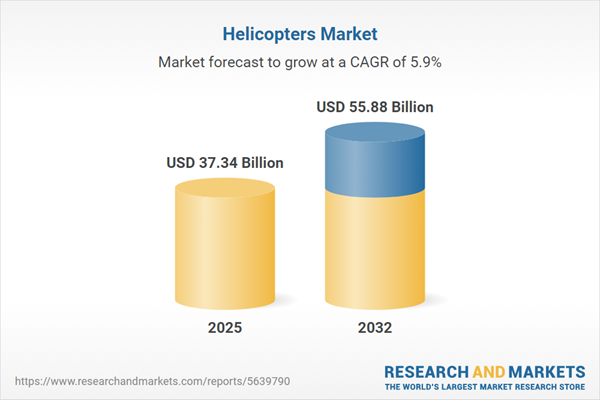Speak directly to the analyst to clarify any post sales queries you may have.
In the evolving landscape of rotorcraft, senior leaders require precise insight into the trends, challenges, and catalysts driving the global helicopters market forward. This report delivers a comprehensive analysis of industry fundamentals, pivotal technologies, and regional developments—supporting informed, forward-focused decisions.
Market Snapshot: Helicopters Market Size and Growth Outlook
The helicopters market saw notable expansion, growing from USD 35.36 billion in 2024 to USD 37.34 billion in 2025. Sustained at a CAGR of 5.88%, it is projected to reach USD 55.88 billion by 2032. This growth reflects rising adoption across diverse civil, commercial, and defense applications, with manufacturers and operators capitalizing on advances in electrification, digitalization, and automation. The demand landscape continues to shift amid regulatory changes and technological innovation, reinforcing the market’s resilience and adaptability.
Scope & Segmentation of the Helicopters Market
This report provides an in-depth assessment of global, regional, and sub-regional trends, focusing on core segmentation areas and emerging innovation drivers:
- Type: Coaxial helicopters, compound helicopters, intermeshing rotor helicopters, single-main rotor helicopters, tandem-rotor helicopters, tilt rotor helicopters.
- Component: Airframe, avionics (communication, flight control, navigation systems), blades & rotors, engine (piston engine, turboshaft), landing gear.
- Propulsion System: Conventional fuel, electric, hybrid.
- Weight Class: Heavy helicopters, light helicopters, medium helicopters.
- Application: Civil & commercial (civil utility, emergency rescue & medical support, offshore, transport & logistics), military (attack & reconnaissance, maritime, search & rescue, training, transport).
- Region: Americas (United States, Canada, Mexico, Brazil, Argentina, Chile, Colombia, Peru), Europe (United Kingdom, Germany, France, Russia, Italy, Spain, Netherlands, Sweden, Poland, Switzerland), Middle East (UAE, Saudi Arabia, Qatar, Turkey, Israel), Africa (South Africa, Nigeria, Egypt, Kenya), Asia-Pacific (China, India, Japan, Australia, South Korea, Indonesia, Thailand, Malaysia, Singapore, Taiwan).
- Key Players: Companies analyzed include Airbus SAS, Boeing, Leonardo, Russian Helicopters, Bell Textron, and others.
Key Takeaways for Senior Decision-Makers
- Technological advances, such as digital twins and autonomous flight algorithms, are reshaping design, manufacturing, and mission reliability standards across civil and defense sectors.
- New propulsion architectures—particularly electric and hybrid systems—are gaining traction spurred by sustainability mandates and policy incentives.
- Regulatory evolution, including urban air mobility certification and software-driven safety standards, is accelerating innovation but adds complexity in compliance and certification processes.
- Global supply chains are adapting through diversified sourcing, expanded partnerships, and increased nearshoring to mitigate disruptions and tariff risks.
- Regional dynamics vary, with North America emphasizing urban mobility and modernization, Europe prioritizing environmental compliance, the Middle East focusing on offshore and air ambulance needs, and Asia-Pacific demonstrating rapid expansion in emergency and defense applications.
- Industry leaders are strengthening competitive positioning by investing in supply chain resilience, advanced analytics, and tailored service offerings that enhance fleet performance and lifecycle value.
Tariff Impact: United States Tariffs and Global Supply Chains
The introduction of new tariffs in the United States has intensified pricing pressure on core components, driving manufacturers towards alternative sourcing and localized procurement. These tariff measures are prompting operators to pursue multi-year agreements and hedge against duty fluctuations, while aftermarket service networks adjust pricing and logistics strategies. The sector has consequently increased its focus on supply chain resilience and inventory decentralization, adapting to ensure continued competitiveness in shifting regulatory environments.
Methodology & Data Sources
This analysis integrates primary insights from executive interviews with OEMs, Tier 1 suppliers, operators, and regulatory authorities. Robust secondary research covers trade sources, technical journals, financial reports, and patent filings. Rigorous validation and peer review ensure data accuracy and nuanced understanding of helicopter market realities.
Why This Report Matters
- Enables senior leadership to anticipate shifts in technology, regulation, and market demand, supporting strategic planning and investment decisions.
- Offers clear benchmarking of competitors and regional performance, identifying emerging opportunities across traditional and developing segments.
- Provides actionable recommendations for product development, supply chain optimization, and market entry strategies tailored to dynamic industry contexts.
Conclusion
The helicopters market is shaped by intersecting technological, regulatory, and geopolitical trends. Stakeholders who embrace innovation and operational agility are well-positioned to capture evolving opportunities and sustain growth in this dynamic industry.
Additional Product Information:
- Purchase of this report includes 1 year online access with quarterly updates.
- This report can be updated on request. Please contact our Customer Experience team using the Ask a Question widget on our website.
Table of Contents
3. Executive Summary
4. Market Overview
7. Cumulative Impact of Artificial Intelligence 2025
Companies Mentioned
The companies profiled in this Helicopters market report include:- Airbus SAS
- Alpi Aviation SRL
- Collins Aerospace by RTX Corporation
- Columbia Helicopters, LLC
- DB Aerocopter Ltd.
- Enstrom Helicopter Corporation
- Helicopteres Guimbal S.A.S
- Hiller Aircraft Corporation
- Hindustan Aeronautics Limited
- Kaman Corporation
- Karem Aircraft, Inc.
- Kawasaki Heavy Industries, Ltd.
- KOREA AEROSPACE INDUSTRIES, LTD.
- Leonardo S.p.A.
- Lockheed Martin Corporation
- MD HELICOPTERS LLC
- Mitsubishi Heavy Industries, Ltd.
- Robinson Helicopter Company
- Rotor X Aircraft
- Russian Helicopters
- Savback Helicopters AB
- Schweizer
- Subaru Corporation
- Textron, Inc.
- The Boeing Company
Table Information
| Report Attribute | Details |
|---|---|
| No. of Pages | 187 |
| Published | November 2025 |
| Forecast Period | 2025 - 2032 |
| Estimated Market Value ( USD | $ 37.34 Billion |
| Forecasted Market Value ( USD | $ 55.88 Billion |
| Compound Annual Growth Rate | 5.8% |
| Regions Covered | Global |
| No. of Companies Mentioned | 26 |









